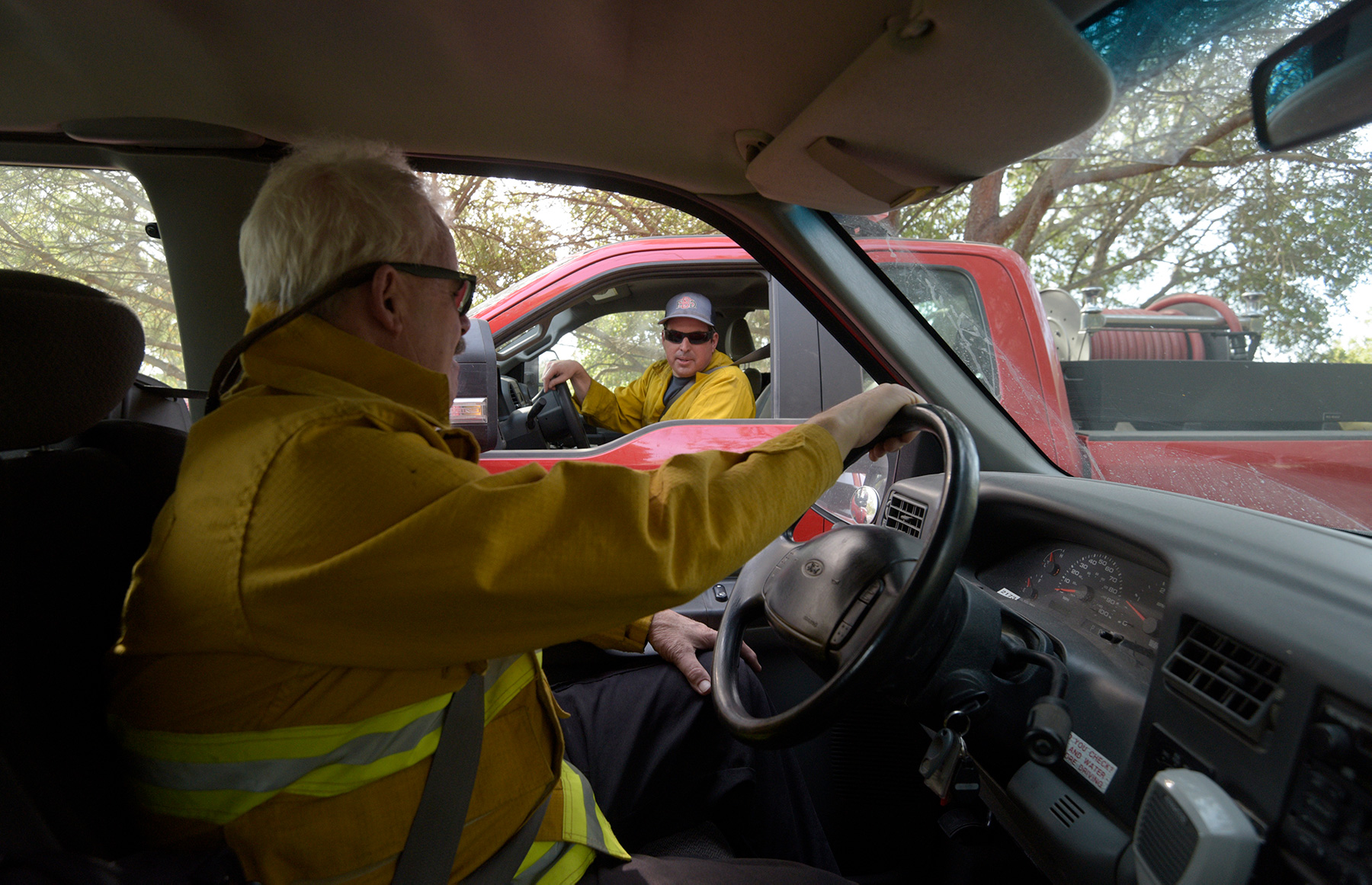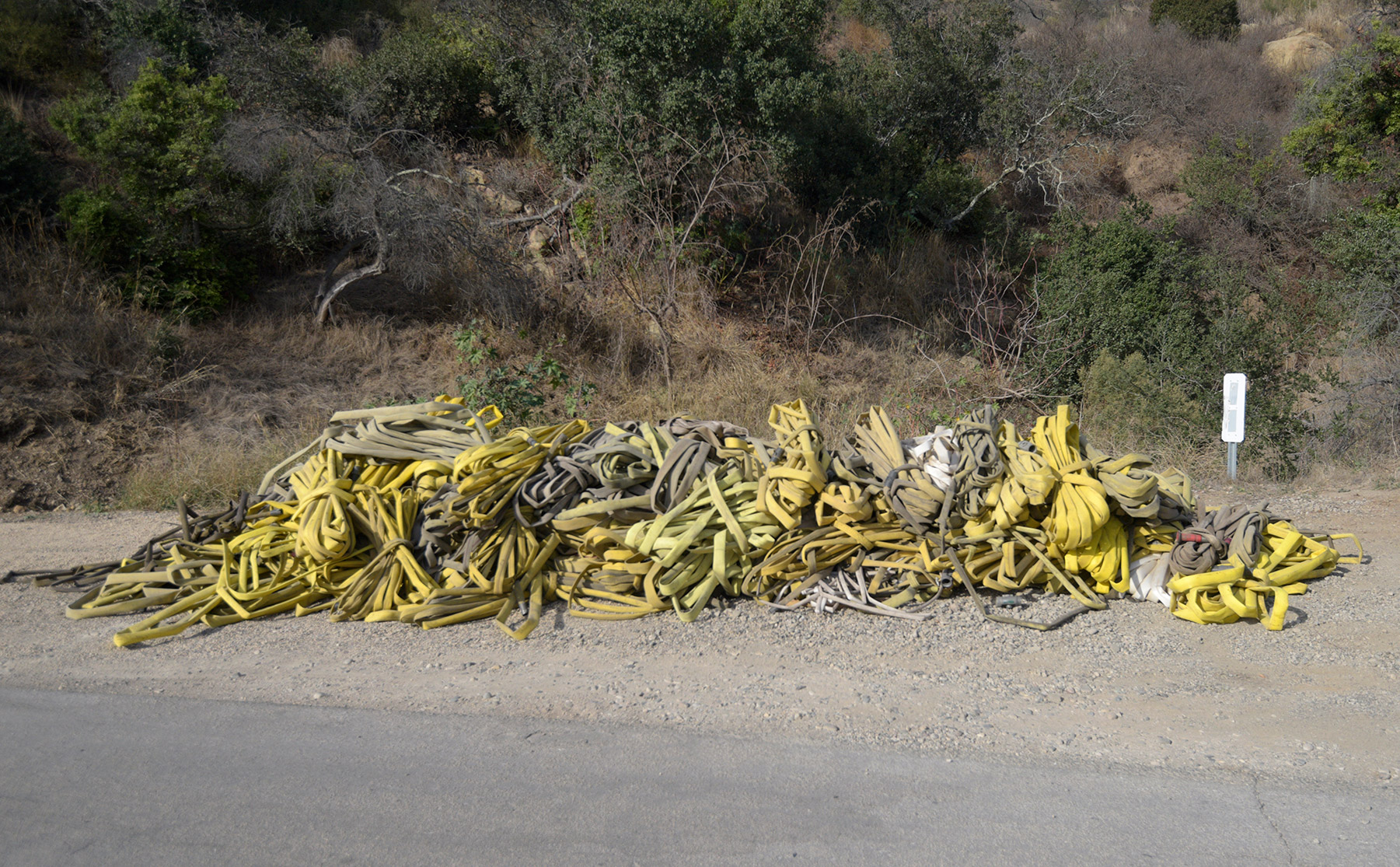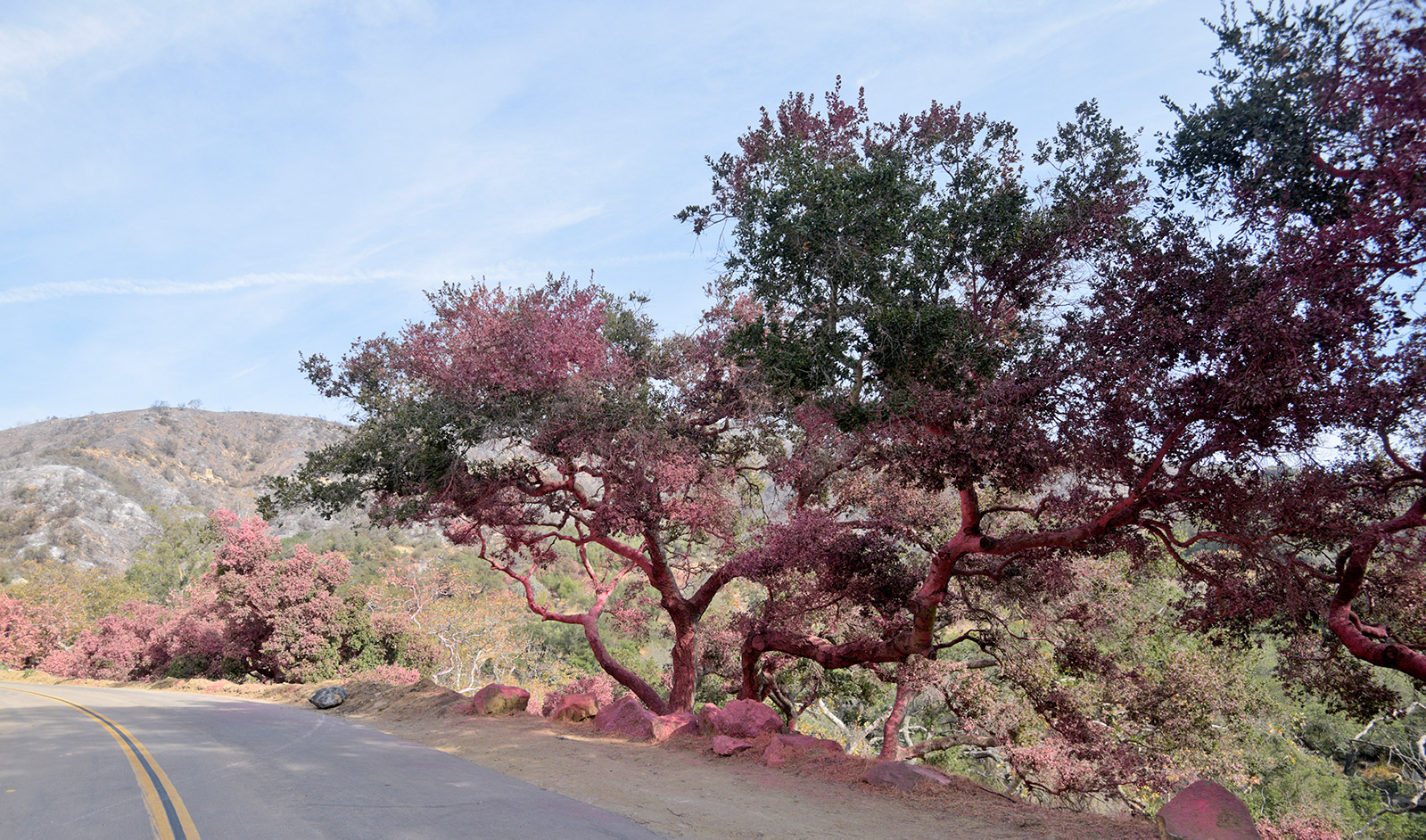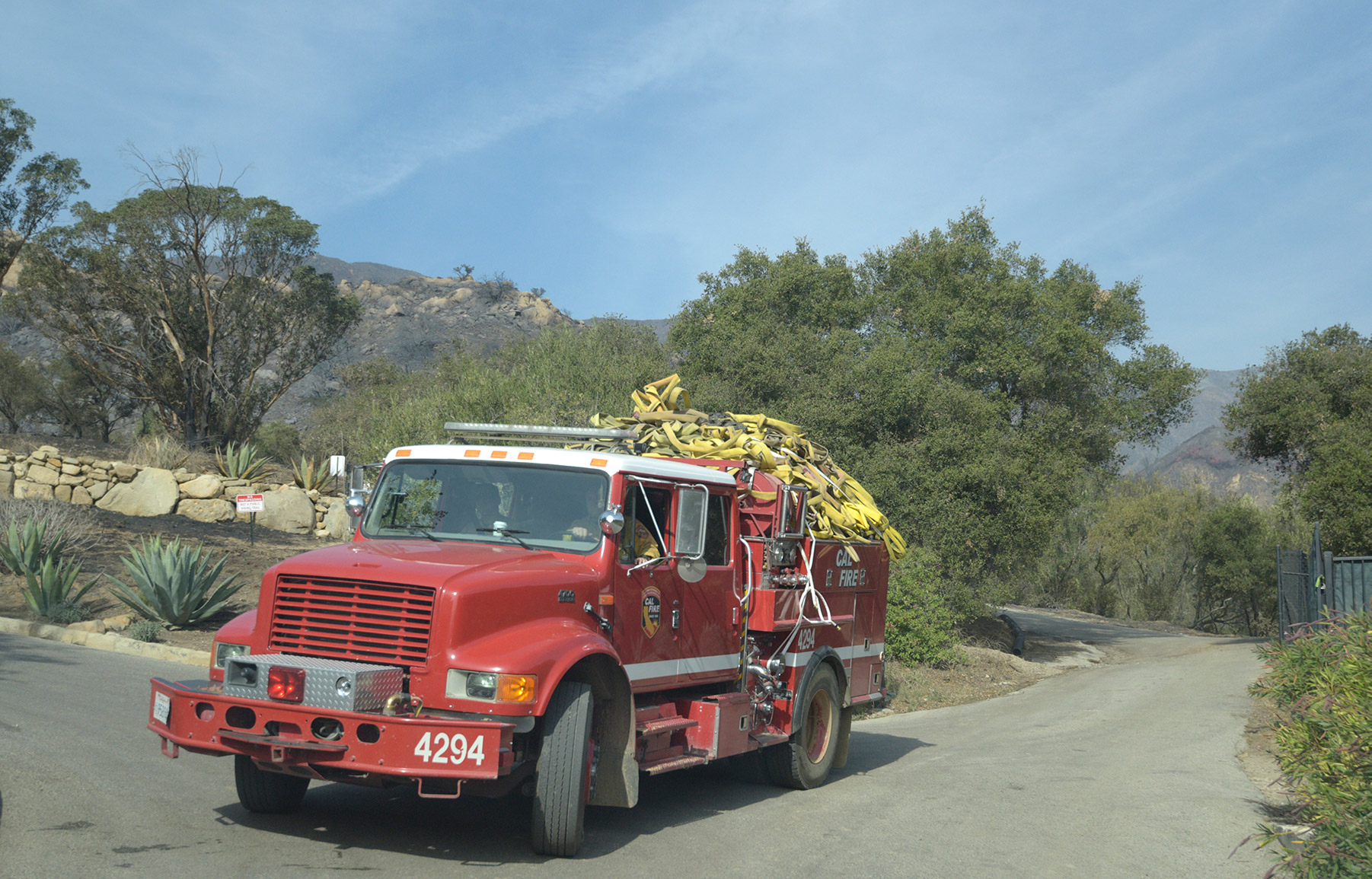Riding Along with Chief Pat McElroy, Surveying the Thomas Fire Damage
Retiring City of Santa Barbara Fire Chief Takes Us for a Ride

Pat McElroy wasn’t in the mood to wax expansive — it was way too soon to pontificate about any lessons learned from the Thomas Fire.
A firefighter for 40 years, and the City of Santa Barbara’s fire chief for the past four, McElroy was busy navigating his fire-engine-red pickup truck along Montecito’s warren of winding backroads — Bella Vista, Park Lane, East Mountain, Riven Rock, Camino Cielo — streets so skinny and steep that even a Vespa might have trouble passing. Upon cruising into the luxurious, historic San Ysidro Ranch, he pointed out the cottage where Winston Churchill stayed and another where John and Jacqueline Kennedy famously honeymooned.
Just two days before, fire trucks of every shape, size, and function had screamed up and down these flame-engorged roads, engulfed in the thickest of smoke. But on Monday morning, the air seemed clear, the sky almost blue. Even the flowers seemed to chirp. Things hadn’t really returned to normal, but had just enough for people to pretend, at least until the next winds blew.
Santa Barbara didn’t merely dodge a bullet last Saturday; it dodged a meteor named Thomas, destined to soon be the biggest wildfire since California started keeping track back in 1932. The only thing that came between the South Coast and annihilation that day was a change of wind speed and direction — well, that, and about 8,500 firefighters from 17 different states who waged the firefight of their lives.

The most striking thing about Monday morning’s ride-along was what we didn’t see. Yes, there were plenty of hillsides drenched generously in Phos-Chek pink and big piles of fire hose heaped like mounds of spaghetti on the roadside awaiting pickup, and some of the surrounding landscape was charred. But what I expected, from covering the aftermath of previous fires, were the charred remains of people’s homes: chimneys and box springs, cracked swimming pools, car carcasses. In two hours, we saw just one property destroyed. Though final numbers aren’t yet available, it appears 10 were damaged that night, with 10 destroyed. Given that 1,300 structures were directly threatened, that’s an astonishing accomplishment.

“The question isn’t the number of homes that were destroyed; the question is how many were saved,” said a Cal Fire public information officer stationed in front of Foodland by San Andres and Micheltorena streets Sunday morning. “The answer is hundreds if not thousands.”
That mantra was manifest Monday morning, with unscathed homes riding the ridges, their existence marvels of modern ingenuity and poor planning combined. Whether such homes belong on such remote, vulnerable terrain remains a debate for another day. But so long as they offer spectacular, $20 million views — in fact, Thomas Fire officials appraised the South Coast’s residential real estate value at $46 billion — that’s probably a conversation that will never happen.
Midway through our drive, McElroy changed his mind about not sharing lessons learned: “Evacuation works.” At the height of the fire, more than 17,000 South Coast residents were ordered to evacuate, and another 30,000 were on evacuation warning. The last thing firefighters want to encounter are untrained civilians who refuse to leave, determined to save their homes — that’s how firefighters get killed.
A coworker at the Independent who lives high atop Mission Canyon refused such an order. When law enforcement officials showed up at her door on Saturday, she didn’t back down. “What’s the name of your dentist?” they asked. “So we can identify you from the dental records.” After laughing at that classic line, McElroy recounted a similar experience he had while trying to evacuate occupants of a Zen monastery during a Marin County fire last year. “I spent a year arguing with them about the impermanence of things,” he recalled, shaking his head. “When did I become a freaking Buddhist?”
The takeaway is that firefighters and fleeing civilians don’t mix. “I can’t even imagine what a mess these streets would be if people were trying to get out while we were trying to get in,” McElroy said. “I don’t even want to try.”

No one knows when Montecito residents can go back home. “Hopefully by Christmas,” speculated McElroy, who said that a lot of work still needs to be done. Utilities have to work, and all fire remnants must be safely snuffed out. Even with no smoke in immediate sight, there are about 50 fire engines planted by Bella Vista and Park Lane, ready to pounce. Said McElroy, “We want to be sure to keep the back door closed.”
McElroy announced his retirement a few hours before the Thomas Fire broke out. He plans to wear his uniform for the last time while marching in New York City’s St. Patrick’s Day Parade on March 17, the day he turns 65. “I’m not part of operations,” he explained of his status on the Thomas Fire. “I’m strictly PR for the city.”
He’s being modest. His department’s brass are embedded in the incident command team, and he personally knows most everyone above the rank of captain in California on this fire, thanks to years of working with them. McElroy has proved ubiquitous throughout the Thomas Fire, translating the cryptic fire-speak of public-safety professionals who never figured out most people can’t tell their north from their south. McElroy has made himself available 24 hours a day to all media inquiries, no matter how clueless, and teamed with Santa Barbara Police Chief Lori Luhnow to expand outreach to our Spanish-speaking neighbors by translating daily updates. “We’re reaching a population that’s traditionally been neglected,” he said. “It’s all about trust. If you give people information they can rely on, they’ll trust you when you tell them it’s time and they have to go.”
Though it’s tough for people to live out of suitcases for two weeks, another lesson of the Thomas Fire is that an overabundance of caution — a k a evacuating people far before the flames arrive — gives firefighters time to prepare for winds on the way. Out-of-town firefighters didn’t merely have time to clear brush, lay hose, and expand defensible space; they were able to learn Montecito’s labyrinthine streets and station in driveways. That made all the difference.
“We had the luxury of time,” said McElroy. “We had a week to prepare. We didn’t have that during the Tea Fire. We didn’t have that during Painted Cave. Ventura didn’t have that when the fire started. There were no resources in place. It’s hard to compare fires fairly. They’re all apples and oranges.”
At a Sunday-night forum, incident commanders could not contain their giddiness, fueled in equal measure by relief and disbelief. What happens next is anyone’s guess. How bad will this week’s winds be? Can the lines at Gibraltar and Camino Cielo hold?
“We’ve been lucky so far,” said McElroy. “But everyone’s still working. As long as people are actively engaged and their lives at risk, I’d say it’s a really bad idea for anyone to start high-fiving each other.”
In the meantime, McElroy is reminded on a daily basis how he’s riding into retirement with the biggest bang of his career, likely the largest wildfire in state history. “Yeah,” he said with evident weariness. “But I could have done without it.”



